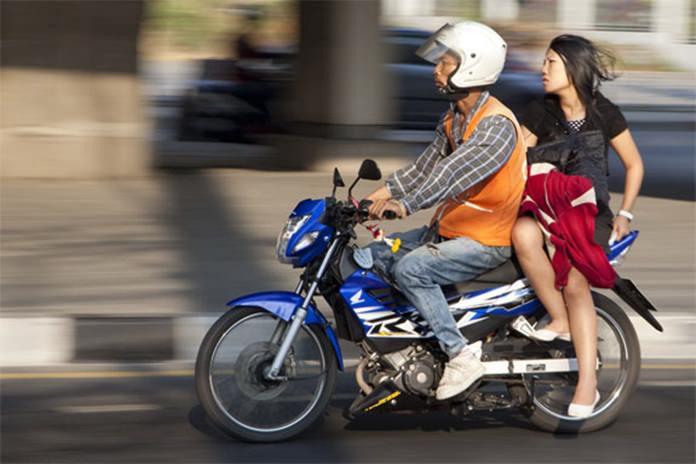This item is really for the “newbies”. When you first arrive in Thailand, the traffic appears to be completely chaotic. At every intersection there appears to be a motorcycle lying on its side with a crowd of onlookers surrounding some bloodied rider and/or pillion passenger. Cars, buses and trucks thunder by at speeds unchecked, and the sheer traffic volume far exceeds that you are used to.

One of the common questions I get asked by new arrivals is, “Do you really drive in this traffic?” This type of query is given even more weight when you find that many multinational companies operating in Thailand do not allow their expats to drive and insist on providing Thai drivers. It then becomes quite a surprise when I inform the awestruck newbie that I do drive, and that it is actually easier to drive in Thailand, than it was driving in Australia or the UK. Those questioners who know of my motor racing background then retort, “Yes, it’s OK for you as you are used to danger and reckless driving, but what about the ordinary folk?”
Firstly, I should point out that in motor racing there are old drivers and bold drivers, but no old, bold drivers! Racing drivers are far from reckless. And so too are Thai drivers, though it may appear the opposite initially.
Despite what it seems on the surface, Thai drivers are actually quite timid compared to those from the West. Four lanes on a highway can filter down into one without aggressive barging. Three lanes can get down into two without the traffic even appearing to slow, as drivers just make room for each other. Does this sound like Melbourne, Manchester or Manhattan? I doubt it.
Of course there is one very different aspect to driving in Thailand that has to be got used to very quickly, and that is the ubiquitous motorcycle. Typical of Asian cities, motorcycles are family transport, delivery vehicles and the ideal commuter chariot. I am waiting for some enterprising motorcycle manufacturer to begin advertising their new 125 cc step-through as “The ideal motorcycle for a family of five”. Don’t laugh, five on a motorcycle is commonplace, in fact you can buy an extra little saddle seat which fits in front of the main seat and is used for small children (who hang onto the rear vision mirrors), or the family dog, which just takes its chances. Mind you, a large percentage of the family pooches travel in the wire basket carrier at the front, cleverly blocking the headlights at night.
Motorcycles are everywhere, though mainly in the left hand lane, but at the intersections they weave their way through the cars in all lanes to end up as a raucous pack at the front. This massed Moto-GP takes off, not on the green, but at some time before the green, when the majority decide it is safe enough to go. Hence the motorcycles lying on their sides in the middle of the intersection, having collided with vehicles playing ‘last across’ from the other direction. I have mentioned before that traffic lights in Thailand seem only advisory, not compulsory!
Successful driving in Thailand does take a fair degree of observation skills, looking out for the dreaded two wheelers. Probably the same observation skills as used in the West to avoid speed cameras, red light cameras and plain clothes police cars. And other drivers with the raging red mist in their eyes.
I could go on for days about the motorcycles. There is a saying here which goes: You know you’ve been in Thailand too long when you look both ways before crossing a one-way street! Motorcycle riders will just happily ride against the flow of traffic and smile and bob their head (usually helmetless) to say “Thank you” as they thread their way through and across your bows.
Motorcycles will also just poke their front wheels into an oncoming stream of cars until it is either stop and let them out (because there is always many more than just one of them), or run into them or into the oncoming traffic.
In the mornings, the motorcycles are people carriers. Some are driven by the school children themselves, all looking as if they are only 10 years old, but are probably at least 13. Yet they are riding with the flow of traffic and not racing each other or the cars and trucks and buses. I know that at 13 years of age if I had been given open slather to ride a motorcycle to school in the traffic, my parents would not have had to worry about what to give me for my 14th birthday. I wouldn’t have made it! Again some essential differences in the mental make-up of our different cultures.
But back to driving here as a farang. There are some ‘rules’ of the road which have to be understood. For example, when the approaching vehicle flashes its lights at you, this does not mean ‘after you’. It means ‘I am coming through’. More than one new driver has been surprised in this way. There is another seemingly uniquely Thai system in which when you are crossing an intersection you turn on the hazard lights. Perhaps it is a hazardous situation crossing an intersection (it probably is) but I have not seen this anywhere else, and I still get confused by it as you wonder whether the vehicle is turning right or left or going straight on. (This item taken from the book Farang, The Sequel.




